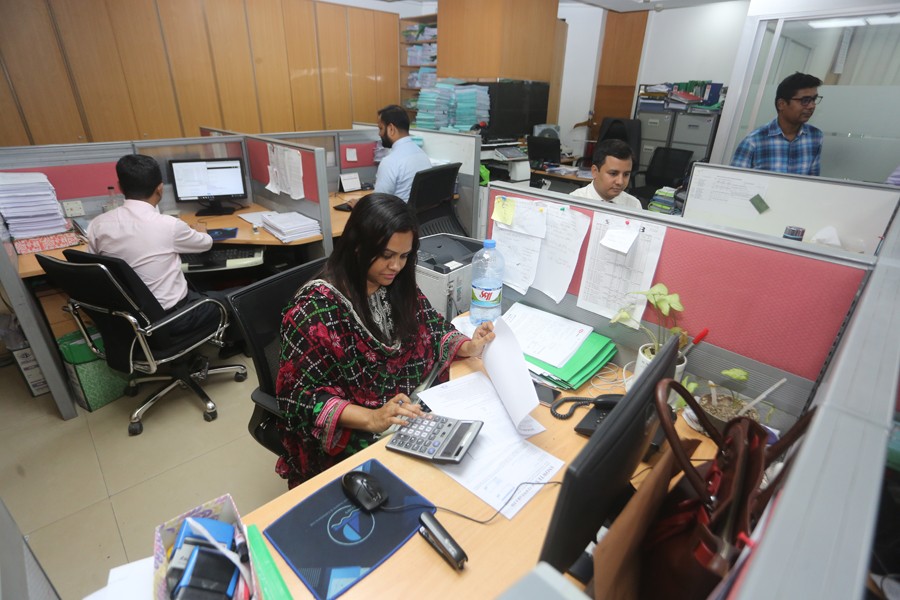Financial actors are realising that the impacts of climate change they predicted as a matter of distant future are, in reality, much closer. Since the Paris Agreement's signing in 2015, climate change has gained massive attention from the financial system.
A recent study by reputed consulting firms Ernst & Young (EY) and Institute of International Finance (IIF) showed 91 per cent of Chief Risk Officers (CRO) of large banks around the world opined climate change is the most significant risk they will face in the next five years. International bodies and governments are tackling climate change by imposing more rigid and stringent regulations. Developed and developing nations are adopting low-carbon economic pathways to meet their obligations of nationally determined contributions (NDC).
The transition to a low-carbon economy requires systematic economic changes which affect all economic sectors, including the financial industry. The financial sector will make the green transformation happen by mobilising large-scale financial resources and hence exposed to the risk of climate change.
In Bangladesh, the climate change risk for the banks and non-bank financial institutions (NBFI) is even higher due to borrower demographics and the geographical location of Bangladesh. Assets managed by financial institutions are heavily exposed to extreme weather events like floods, drought, cyclones etc. Extreme climatic events may cause substantial losses for businesses, firms and households and diminish their capacity to repay loans. This triggers the bank's credit risk since it increases the probability of default, other than lowering the price of the mortgaged property bank holds from the borrower. Since Bangladesh is highly vulnerable to climate extremes, an increment of such events will ultimately skyrocket the risk of default loans for banks and NBFI.
From the resource and capacity standpoint, the physical risk of climate change is higher for SME loans. These small groups of businesses have less capacity to deal with the heightened climate change risk than other firms, as they often lack good governance, resources, liquidity, skilled manpower, and technical capability. Consequently, the bank, as a fund manager, will find it difficult to finance those businesses due to low creditworthiness. On the other hand, climate-proofing the business for SMEs is difficult due to funds' unavailability. The circularity of this problem will slow the economic growth of Bangladesh as a whole eventually.
Besides the physical risk, climate change poses a severe transition risk to financial institutions, particularly for corporate or large loans. Climate transition risk to banks is more financially correlated than physical risk and is expected to happen sooner. The goal of limiting global warming to 1.5 degrees Celcius will obsolete many businesses faster than we thought.
Regardless of direct or indirect exposure, the climate policies will hit harder the fossil fuel-based assets of a bank shortly. Most Bangladeshi banks depend on the credit line provided by the reputed global commercial banks and multilateral development banks (MDBs) for their trade business. Soon those international banks will no longer provide their credit line to those with high exposure to fossil fuel-based business.
For example, our local banks currently cannot use Asian Development Bank's credit lines to finance coal-based businesses. The list of excluded items of foreign banks will be enormous day by day from the standpoint of greenhouse gas emissions. During the Conference of the Parties meeting at Glasgow (COP-26), the world's largest banks and financial institutions, including Bank of America, Deutsche Bank, Credit Suisse, BNP Paribas, HSBC, Citi, Standard Chartered around the world formed an association called Glasgow Financial Alliance for Net Zero (GFANZ) under United Nations (UN).
Since launching in April last year with 160 members, Alliance membership has grown to over 550 members from 50 countries. Those member financial institutions control around 40 per cent (68 Trillion US dollars) of global private financial assets. They are gradually phasing out their fossil fuel-based exposure as part of their commitment to achieving net zero by 2050. Shortly, those member banks will not be able to support a transaction that contributes to greenhouse gas emissions directly or indirectly. Two financial institutions from Bangladesh, The City Bank and IDLC Finance, have also joined the alliance.
Climate-induced credit risk will be the main emerging risk for banks and financial institutions for the next decades. It will affect banks' balance sheets and operations over time. To withstand better, a bank should first identify and quantify its lending portfolios' physical and transition risk exposure.
As soon as the climate risks are identified, they should be reflected in the overall risk rating of the borrower. Climate risk rating should be integral to the banks' Internal Credit Risk Rating System (ICRR). Although there is an Environmental & Social Risk Rating system as part of the due diligence process, it rarely affects the decision of the loan approval process. To overcome the transition risk of Climate change, science-based climate scenarios need to be used for fund allocation. Shifting away financial flow from high-emitting assets to green assets should be the centre of the exercise.
Besides, climate change will bring enormous business opportunities for financial institutions if they can transform. To limit global warming to 1.5 degrees Celcius an additional amount of 1 Trillion US Dollars in investment will be required for the clean and renewable energy sector alone. Building resilience for the manufacturing and agricultural sector will also need a vast financial flow. Seizing the opportunities brought by climate change through innovative climate and environment-friendly financial product offerings will help the financial industry to absorb the climate shocks and thrive.
Banks need to address climate change from the perspective of credit risk rather than reputational risk or corporate social responsibility issues. As a macro-prudential authority, the central bank can lead this new dimension of risk management with necessary regulatory support. Central banks' progress in recent years has been very significant, although there is still a way to go.
The writer is an Environmental Economist and Green Finance professional. [email protected]


